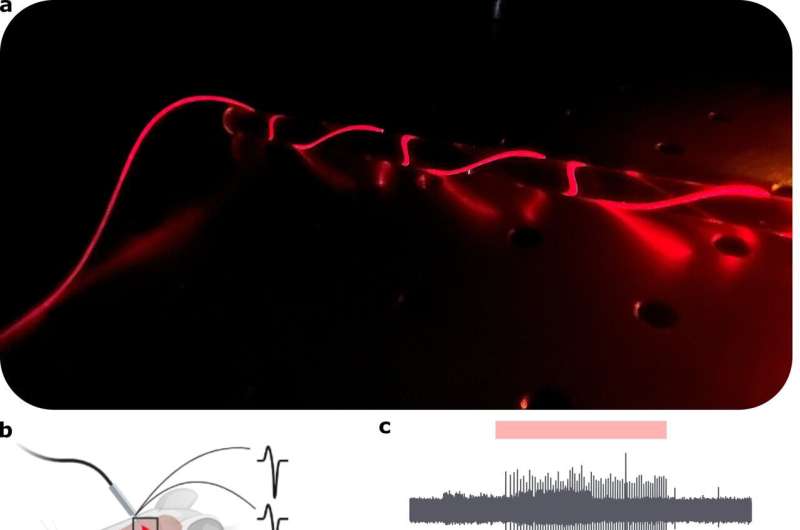This article has been reviewed according to Science X's editorial process and policies. Editors have highlighted the following attributes while ensuring the content's credibility:
fact-checked
peer-reviewed publication
proofread
Controlling and recording brain activity with infrared flexible optoelectronic fibers

Optogenetics and infrared neurostimulation (INS) constitutes a powerful toolbox in neuroscience to study and control neuronal activity using light. The latter optical method (INS) is recently gaining momentum as a transgene-free optical technique to investigate both the central and peripheral nervous system and therefore constitutes a promising therapeutic approach for neurological and neurodegenerative diseases.
Until now, soft, biocompatible infrared fiber-based neural interfaces had never been reported. Furthermore, most INS research relies on uni-directional glass fibers rather than bi-directional interfaces that can simultaneously stimulate and record activity.
In a new paper published in Light: Science & Applications, a team of scientists, led by Professor Christos Markos, head of the Neural Devices and Gas Photonics group, Department of Electrical and Photonics Engineering, Technical University of Denmark and Professor Rune W. Berg, head of Berg's Lab, Department of Neuroscience, University of Copenhagen have developed a new integrated optical fiber based on non-conventional soft optical polymers able to transmit infrared light at wavelengths previously inaccessible for this class of materials.
This fiber constituted the base for the development of soft, bi-directional neural interfaces for infrared light delivery within the brain tissue of rodents and collection of the generated electrophysiological signals. The developed implants can accomplish this challenging task with minimal tissue inflammation. A new INS protocol was established and validated using the developed interfaces in vivo without damage to the neuronal tissue by the infrared pulses.
The interfaces were tested and compared in vivo both acutely (under anesthesia) and in chronic experiments to verify their robustness over several weeks against standard recording electrodes. The reported method and device will pave the way towards new investigations of brain circuitry using INS in chronic experiments, and enhance the possibility of translating this powerful technique to clinical settings.
The presented fiber neural interfaces based on high-performance polymers constitute a platform that can in the future see the integration of more functionalities, such as in situ drug delivery and fluorescent imaging, to provide neuroscientists with a versatile tool to study different brain circuits and functions with high spatial resolution and without need of genetic manipulation. The scientists summarize the main novelties introduced by their work:
"This paper is a multi-disciplinary breakthrough reporting: i) the fabrication of a novel optoelectronic polymer fiber capable of transmitting light at infrared wavelengths (2 μm), which creates new research directions for the fiber-optic community in this spectral band, ii) the use of the softest thermoplastic perfluorinated polymer for enhanced biocompatibility, flexibility and ultra-high numerical aperture, iii) the application of this novel fiber in developing the first monolithic, soft, multi-functional, biocompatible INS interface."
"Our soft neural interfaces could significantly move forward the use of this technique in deep brain regions and chronic settings, to gain a better understanding of neural mechanisms at a circuit level. The biocompatibility and sterilizability of the used fiber materials, can also increase the potential for translation of the findings towards development of new therapies for neural diseases in humans," the scientists say.
More information: Marcello Meneghetti et al, Soft monolithic infrared neural interface for simultaneous neurostimulation and electrophysiology, Light: Science & Applications (2023). DOI: 10.1038/s41377-023-01164-9





















